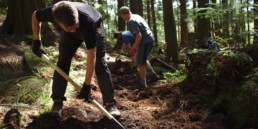An Easy Way to Toughen Trails
Locate trails on side slopes whenever possible. Flat areas should be avoided because they become overwhelmed by water and sand. Flood plains, river bottoms, plateaus, meadows, even old roads – trails in these places can turn into mud bogs or sand traps that require continual maintenance. Trails that traverse side slopes are called contour trails. They provide good drainage, are far more appealing and will pass the test of time. Here are four ways to spice up a contour trail with ups and downs:
Grade reversals
On side slope traverses, you can make the route more interesting by “surfing” the contour lines. Create a rolling trail that dips and rises frequently. Reverse the grade subtly about every 20-40 feet. Visualize rhythmically spaced “waves”. Remember that the trail grade must always remain less than half the side slope grade. For example, if you’re building across a mountainside that slopes at 40%, no part of the trail should exceed 20% – and we recommend 10% as a maximum overall trail grade. Route the trail on the uphill side of established trees to utilize the bench and avoid their roots. Use natural obstacles to provide barriers to surf around. Grade reversals will make a trail fun and also improve drainage. (See photo)
Grade breaks
A common trail design error is lack of grade changes. Long runs of constant grade encourage excessive speed (if downhill), are boring (if uphill), and can result in erosion if water focuses down the path. We recommend interrupting climbs and descents with breaks, where possible. Long climbs with short descents mixed in allow users to regain their momentum and catch their breath. On downhills, short climbing interludes provide variety, challenge and keep riders off their brakes. Lengthy runs allow water to gain speed and may contribute to erosion. Grade breaks ensure water stays off the trail.
Constant ups and downs
If your local terrain is generally flat, it is especially important to use short ups and downs to challenge riders. Make use of every available change in terrain. The ’96 Olympic mountain bike course in Conyers, Georgia, is a good example. This race course is always going up or down. Despite a lack of big hills in the area, the track is very challenging because racers never have chance to rest.
Gravity drops
The goal is to create a large dip in the trail with an equal rise after the fall. Riders drop in one side and their momentum shoots them up the opposite side. G drops are one place where the trail grade can be a bit steeper than we would normally recommend. The key factor is a smooth transition and a clear sight line. If it is designed correctly, an average rider should not have to brake. By not using their brakes, mountain bikers won’t pull dirt down the steeper section of trail. G drops should not be used on trails that have a lot of hiker and horse traffic. These other users will tend scrape the downhill grade, increasing erosion. Good sight lines are key: riders must be able to see the entire drop from either side. Remember to keep the trail grade under half the sideslope grade and to limit steep sections to 15-to-30 feet.
Experiment with these trail features, realizing that some soils have less integrity and are difficult to work with. Learn what works best in your area. Build exciting trails and build them to last.



